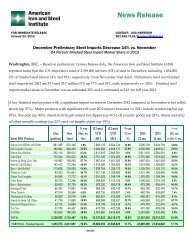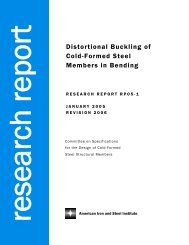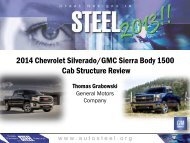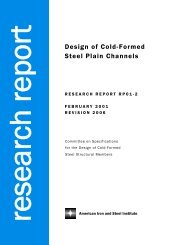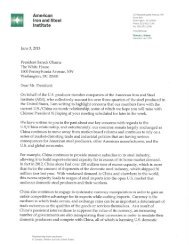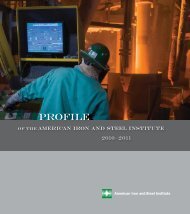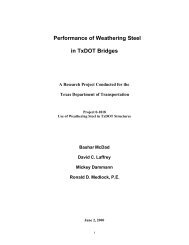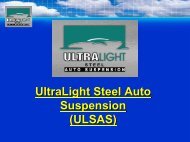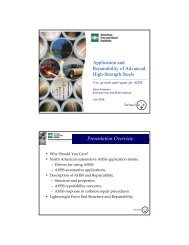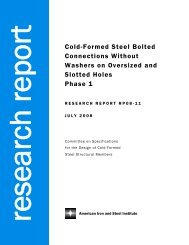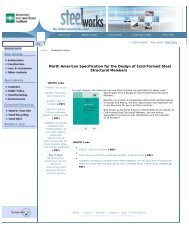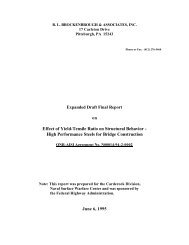Environmental Life Cycle Assessment of Southern Yellow Pine ...
Environmental Life Cycle Assessment of Southern Yellow Pine ...
Environmental Life Cycle Assessment of Southern Yellow Pine ...
Create successful ePaper yourself
Turn your PDF publications into a flip-book with our unique Google optimized e-Paper software.
EXECUTIVE SUMMARY<br />
1.5.2.1.3 Key Species Loss <br />
Key species included in the study were those on the US Forest Service (USFS) Threatened and <br />
Endangered Species list, or the International Union for the Conservation <strong>of</strong> Nature Red List <strong>of</strong> <br />
Threatened Species. 34,35 The assessment for terrestrial habitat disturbance was based on the same <br />
methods used to assess terrestrial biome disturbance; however, no data were available to quantify <br />
the spatial extent or severity <strong>of</strong> disturbance to wetland or freshwater habitats. The list <strong>of</strong> species <br />
impacted was compiled without assessment <strong>of</strong> these distinct category indicators. <br />
When considering the number <strong>of</strong> species impacted, the BAU scenario has higher impacts, affecting <br />
almost 90 species. Seven <strong>of</strong> these species experienced disturbance to terrestrial habitats, for which <br />
indicator results were assessed. An additional eighty-‐one <strong>of</strong> these species experienced disturbance to <br />
freshwater and/or wetland habitats; however, indicator results could not be quantified for these <br />
species, due to a lack <strong>of</strong> data. <br />
1.5.3 Lower Hazardous Emissions Associated with Impacts to Humans, Flora and Fauna <br />
Emissions from arsenic and chromite ore extraction, required for CCA production, have impacts that <br />
are significant in nature and large in spatial extent. Another impact to human health is the degree to <br />
which workers are exposed to toxic herbicides during forestry operations. These are primary <br />
consequences <strong>of</strong> the BAU scenario; the secondary consequences from implementation <strong>of</strong> the SPR <br />
scenario are projected to lead to a decline in arsenic ore mining and smelting activities in China, <br />
resulting in impact reductions for human health and the environment. <br />
1.5.3.1 Emissions from Arsenic Ore Extraction <br />
Due to environmental concerns from mining and smelting, arsenic trioxide has not been produced in <br />
the United States since 1985. In response to environmental concerns and human health issues, the <br />
wood-‐preserving industry made a voluntary decision to stop using CCA to treat wood for decks and <br />
outdoor residential use in 2003; however, because <strong>of</strong> known performance and lower costs, CCA is still <br />
used in nonresidential applications, such as the treatment <strong>of</strong> utility poles. 36<br />
Due to this voluntary ban on CCA use for most wood products, imports <strong>of</strong> arsenic trioxide (the <br />
primary chemical constituent <strong>of</strong> CCA) into the United States have declined since 2003 by roughly <br />
70%, when roughly 20,000 tons <strong>of</strong> this material was imported. The arsenic trioxide used in the BAU <br />
scenario is mined in China, by far the largest producer <strong>of</strong> arsenic trioxide worldwide. 37 China <br />
produces significant amounts <strong>of</strong> arsenic ores (primarily realgar and orpiment), and also manufactures <br />
34 United States Fish and Wildlife Service: Endangered Species Program. Species Searchmap. Accessed on 2/24/2012 from <br />
http://www.fws.gov/endangered/species/index.html. <br />
35 International Union for the Conservation <strong>of</strong> Nature: Red List <strong>of</strong> Threatened Species. Accessed on 2/24/2012 from <br />
http://www.iucnredlist.org/ <br />
36 USGS Minerals Commodity Summary 2012. Arsenic. http://minerals.usgs.gov/minerals/pubs/commodity/arsenic/mcs-‐<br />
2012-‐arsen.pdf <br />
37 The Encyclopedia <strong>of</strong> Earth: Arsenic. Retrieved on 4/6/2012 from <br />
http://www.eoearth.org/article/Arsenictopic=49557#gen1 <br />
April 2013 | ©SCS Global Services <br />
ES-‐ 17



